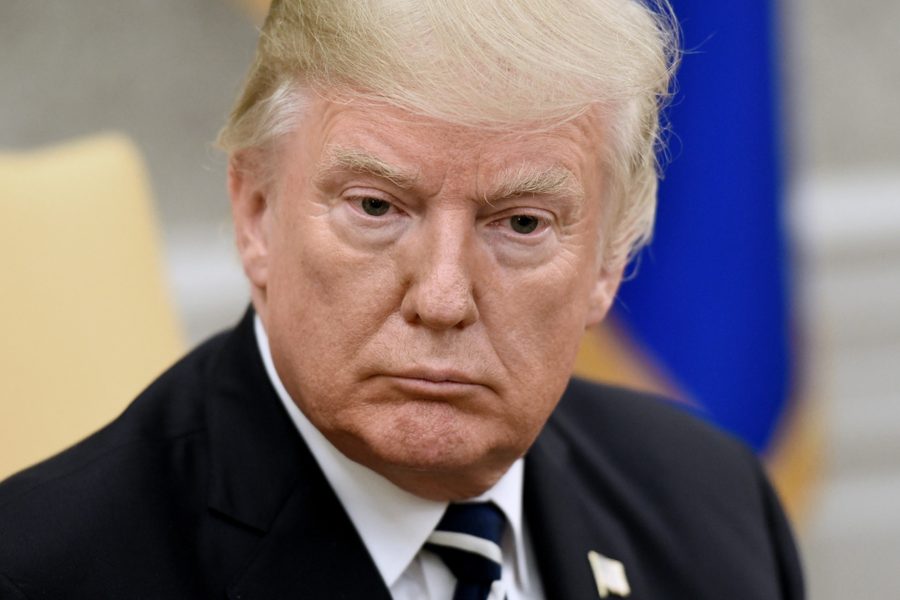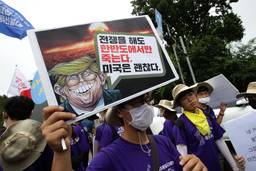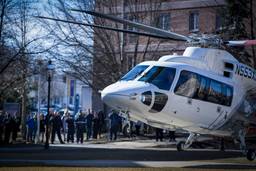Trump Is Bringing Us to the Brink of War with North Korea—Where Is the Anti-War Movement?
The only way forward on North Korea is peace. But first we need dialogue.
Christine Ahn

Tensions have been running high between the United States and North Korea since Donald Trump entered the White House. But the two countries haven’t been this close to war since 1994, when the administration of Bill Clinton weighed a first strike on North Korea.
The spark that conflagrated the already incendiary relations between Washington and Pyongyang was President Donald Trump’s U.N. speech on September 19, when he called the North Korean leader Kim Jong-Un “Rocket Man” and threatened to “totally destroy North Korea,” a sovereign nation of more than 25 million people. In a revival of Harry S. Truman’s McCarthyism and George W. Bush’s “Axis of Evil,” Trump cast North Korea, Iran and Venezuela as rogue regimes that Washington is prepared to confront. He noted that Congress just handed him $700 billion, making the U.S. military “the strongest it has ever been.”
Over the weekend, Secretary of State Rex Tillerson said that the United States has a few open channels of communication with North Korea, making a nod towards potential diplomacy. But Trump quickly undermined his own Secretary of State when he tweeted that Tillerson was “wasting his time trying to negotiate with Little Rocket Man.” The USS George Washington, a nuclear aircraft carrier, is now barreling towards North Korea, and strategic assets have been moved from U.S. bases in Guam and Okinawa to South Korea.
As the situation spirals rapidly out of control, three important points need reminding. First, Trump is making the moral calculus that by engaging in dangerous brinksmanship, he is willing to endanger millions of innocent lives in North Korea, South Korea and Japan — and possibly in Guam, Hawaii and the continental United States. Second, diplomacy with North Korea has succeeded in the past, but it requires actually engaging with North Korea, not further isolating it by imposing more sanctions and forcing other nations to cut ties. Third, Americans must realize that we are mired in this conflict because of the large-scale U.S. destruction of North Korea during the 1950-53 Korean War.
From war of words to potential military conflict
In the seven-decade history of the United Nations, never has a head of a member state threatened the total annihilation of another member state. If Charlottesville was a moment when neo-Nazis took off their hoods, then Trump’s U.N. speech exposed the U.S. Empire’s unabashed drive to aggressively dominate those countries it opposes.
When Trump threatened genocide on North Koreans, he failed to mention that the crisis we are in today stems from the fact that the United States unleashed staggering destruction on North Korea during the Korean War. Sometimes referred to as the “Forgotten War,” the U.S. onslaught killed millions of Koreans in just three years.
Kim Jong-Un fired back that Trump’s threats “have convinced me, rather than frightening or stopping me, that the path I chose is correct and that it is the one I have to follow to the last.” Trump tweeted in response, calling Kim Jong-Un “a madman who doesn’t mind starving or killing his people” and claiming the North Korean head of state “will be tested like never before.”
Trump quickly moved to turn his threats into a display of military confrontation. During the night of September 23, the U.S. Air Force flew B-1 Lancer bombers north of the Military Demarcation Line, technically into North Korean territory, the farthest north U.S. fighter planes have flown in the 21st century. Some speculated that the Trump administration acted unilaterally, when in fact Moon authorized the flight.
In response, a coalition of major peace organizations representing tens of thousands of South Koreans — including People’s Solidarity for People’s Democracy, Young Women’s Christian Association and Women Making Peace — issued a statement on September 25 protesting the military action. “The Moon Jae-in government should have rejected such military protest,” the statement read. Jeong-ae Ahn-Kim of Women Making Peace told In These Times that massive protests have been taking place outside of the U.S. Embassy in Seoul and will continue.
On September 25, as North Korean Foreign Minister Ri Yong-ho departed New York, he announced that the United States has “declared war on our country” and that North Korea has the right to defend itself, “including the right to shoot down United States strategic bombers even when they are not inside the airspace border of our country.”
Playing with fire
Although a military confrontation between the United States and North Korea would be unimaginable, many are beginning to predict how it will unfold. In a terrifying article in The Los Angeles Times, Barbara Demick looks at how a U.S. war with North Korea would be fought. Demick begins her fearmongering piece with, “This is the way a nuclear war begins.” She quotes Rob Givens, a retired Air Force brigadier general who was stationed in South Korea, as saying: “There is only one way that this war ends. With North Korea’s defeat — but at what cost?”
That is the moral quandary the Trump administration is — we can only hope — seriously weighing as it considers military action against North Korea. “When Mr. Trump threatens to annihilate 25 million people in North Korea, he is endangering 51 million South Koreans,” said Jeong-ae Ahn-Kim, of Women Making Peace in South Korea, in an email sent to In These Times. “Millions of South Koreans have family in the North. When he threatens them, he threatens us.”
Even top Trump administration officials acknowledge that U.S. military action would be catastrophic. “It will involve the massive shelling of an ally’s capital, which is one of the most densely packed cities on earth,” U.S. Secretary of Defense James Mattis warned Congress in June 2017 when asked why Washington wouldn’t just go to war with North Korea to prevent it from acquiring the capability to strike the United States. “It will be a war more serious in terms of human suffering than anything we’ve seen since 1953.”
“There’s no military solution, forget it,” Steve Bannon told Robert Kuttner of The American Prospect on his way out of the White House last August. “Until somebody solves the part of the equation that shows me that ten million people in Seoul don’t die in the first 30 minutes from conventional weapons, I don’t know what you’re talking about, there’s no military solution here, they got us.”
Yet, administration officials ultimately are not preventing Trump’s dangerous escalation. The day before Trump’s U.N. Speech, when asked if there were any military options that would not endanger Seoul, Secretary of Defense Mattis said, “Yes there are. But I will not go into details.”
In recent weeks, there has been a decisive shift by Washington towards military action. Many were hopeful that an off-ramp emerged as a possibility during the August U.S.-South Korean “Ulchi Freedom Guardian” war drills, when the United States reduced the number of U.S. troops by 7,500 — a sizeable cut from 25,000.
Unfortunately, according to veteran journalist Tim Shorrock, “the key elements of the exercises, including training in ‘decapitation strikes’ on the North Korean leadership, remained.” This led to a counter-reaction from Pyongyang in the form of two missile tests, including over the Japanese island of Hokkaido. On September 2, North Korea conducted its sixth nuclear test. It was then that McMaster started “speaking openly of a ‘preventive war,’” Shorrock explains, aimed at stopping “North Korea from threatening the United States with a nuclear weapon.”’
Threat of regional escalation
Many analysts believe the escalation is fueled, in part, by Japan, whose neoconservative Prime Minister Shinzo Abe has become Trump’s closest foreign ally. In fact, the U.S. government appears to be sidelining South Korea, which is now headed by the liberal Moon Jae-in, who insists that a conflict on the Korean peninsula would not happen under his watch.
Abe was Trump’s first foreign dignitary invited to his Mar-o-Lago resort, and it was during this visit that North Korea fired a missile as a message to both Washington and Tokyo. As University of Chicago historian Bruce Cumings said in March, “basically, 70 or 80 years of history is represented by that particular missile test.“ Abe’s grandfather was Kishi Nobusuke, a Class-A war criminal from World War II who hunted down, imprisoned and tortured Korean guerrillas fighting for Korean independence from Japanese colonialism. Among them was Kim Il-Sung, the founder of the Democratic People’s Republic of Korea and grandfather to Kim Jong-Un.
President Moon came into office promising reconciliation between the two Koreas, not quite in alignment with Trump’s strategy to choke off Pyongyang. This approach reflects public opinion: In survey after survey, eight out of ten South Koreans express a desire for peace and reconciliation with their neighbors in the north.
Yet, in reality, Moon has largely gone along with the Trump administration’s aggression towards North Korea and China. He installed the U.S. THAAD missile defense system in Seongju, despite earlier promises to conduct a year-long environmental impact review.
At the same time, Moon has defied calls for complete isolation of North Korea by committing $8 million to the U.N. for humanitarian aid to North Korea. Moon has also vowed to review his impeached predecessor’s bilateral agreement with Abe forgiving Japan’s wartime sexual slavery of hundreds of thousands of Korean, Chinese, Filipino and other women and girls.
Yet, the United States, South Korea and Japan are all on the same page when it comes to profiting from the ongoing Korean conflict. On September 5, Donald Trump tweeted, “I am allowing Japan and South Korea to buy a substantially increased amount of highly sophisticated military equipment from the United States.” Mark Lippert, the former U.S. Ambassador to South Korea, now heads government relations for Boeing, to ensure a steady stream of fighter jets to Seoul.
Just as the United States needs the ongoing Korean conflict to sell more weapons, Japan is using the North Korean conflict to justify eliminating its Peace Constitution, including Article 9. According to Kozue Akibayashi, Professor at Doshisha University in Kyoto, Japan, “Abe is using the North Korean nuclear threat to justify more militarization, such as revoking Article 9, which threatens the security of the entire region.”
Reviving the U.S. Anti-War Movement
The time is now for mass mobilization and opposition to Trump’s drive for preemptive war on North Korea. According to a poll conducted in September by The Washington Post and ABC News, two thirds of Americans oppose a preemptive military strike against North Korea. Now, it’s the peace movement’s role to ensure that the Trump administration is held to account and pursues genuine diplomatic engagement to resolve the standoff.
The Trump administration will hopefully arrive at this conclusion and agree to negotiate a non-aggression pact that would reduce the threat of a North Korean counter-attack — and could freeze their nuclear and missile weapons development. But first it must agree to talk with North Korea unconditionally.
The good news is that there is a viable proposal now to freeze North Korea’s nuclear and missile program in exchange for a halt to the U.S.-South Korean military exercises. It was first introduced by Pyongyang and is now backed by China and Russia. According to Kye Chun-yong, the North Korean ambassador to India, “We are willing to talk in terms of freezing nuclear testing or missile testing … if the American side completely stops big, large-scale military exercises temporarily or permanently, then we will also temporarily stop. Let’s talk about how to solve the Korean issue peacefully.”
Even President Moon’s senior advisor Moon Chung-in has proposed that South Korea consider scaling back the exercises to eliminate the most threatening aspects. Many U.S. experts say such a move would be fair and do little — or nothing at all — to weaken the U.S.-South Korean deterrence capability.
A growing number of former U.S. officials support the dual freeze proposal, including former State department official John Merrill, who told PBS, “A freeze-for-freeze option is the only remaining viable option to defuse the current crisis. It is actionable and carries relatively little risk. If successful, the payoff could be peace.”
There is a precedent for halting U.S.-South Korean war exercises. In 1992, George Bush senior suspended the Team Spirit exercises, which led to North Korea allowing the International Atomic Energy Agency to inspect its main nuclear facility, which in turn led to the discovery that the North had a secret nuclear program. The war drills were re-started in 1993, then planned but not executed during the 1994 negotiations that culminated in the Agreed Framework that froze North Korea’s nuclear program for more than eight years. According to former Secretary of Defense William Perry, North Korea could have produced enough plutonium to build fifty nuclear bombs a year.
Another actionable step the anti-war movement can take is to urge Congress to reign in Trump by limiting his ability to authorize a first strike on North Korea without Congressional approval. Like the Markey-Lieu bill restricting first use of nuclear weapons, this bill would prevent Trump from initiating military action without Congressional authorization.
Time is not on the Trump administration’s side. Every time North Korea conducts a missile or nuclear test, it is perfecting its ability to strike the U.S mainland as a deterrent against a military invasion. Like Obama acknowledged with Iran, Trump must realize that it is better to freeze North Korea’s nuclear and missile program before it can reach Washington, D.C. Representative John Conyers, one of two surviving Korean War veterans still in Congress, is spearheading legislation to restrict Trump’s ability to launch a first strike.
Finally, the U.S. peace movement must push for a final settlement of the unresolved Korean War with a Peace Treaty. We are in this crisis today because a fragile ceasefire has been in place for 64 years. North Korea is a nuclear-armed state, and given what happened to Iraq, which didn’t possess weapons of mass destruction, North Korea is not about to become victim to another U.S. military regime-change invasion. Furthermore, Trump’s threats to abrogate the Iran deal aren’t helping persuade the North Korean regime to de-nuclearize.
Pyongyang won’t even consider abandoning their nuclear weapons program as long as they are being threatened with “fire and fury like the world has never seen,” as President Trump has forewarned. Peace and diplomacy is the only way forward, and the first step is dialogue — unconditionally.

I hope you found this article important. Before you leave, I want to ask you to consider supporting our work with a donation. In These Times needs readers like you to help sustain our mission. We don’t depend on—or want—corporate advertising or deep-pocketed billionaires to fund our journalism. We’re supported by you, the reader, so we can focus on covering the issues that matter most to the progressive movement without fear or compromise.
Our work isn’t hidden behind a paywall because of people like you who support our journalism. We want to keep it that way. If you value the work we do and the movements we cover, please consider donating to In These Times.




